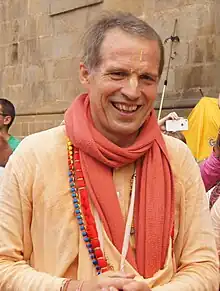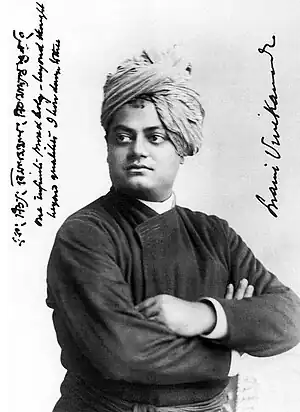Hinduism in the West
The reception of Hinduism in the Western world begins in the 19th century, at first at an academic level of religious studies and antiquarian interest in Sanskrit.
History
Colonial period
During the British colonial period the British substantially influenced Indian society, but India also influenced the western world. An early champion of Indian-inspired thought in the West was Arthur Schopenhauer who in the 1850s advocated ethics based on an "Aryan-Vedic theme of spiritual self-conquest", as opposed to the ignorant drive toward earthly utopianism of the superficially this-worldly "Jewish" spirit.[6]
In the early 20th century, Western occultists influenced by Hinduism include Maximiani Portaz – an advocate of "Aryan Paganism" – who styled herself Savitri Devi and Jakob Wilhelm Hauer, founder of the German Faith Movement. It was in this period, and until the 1920s, that the swastika became a ubiquitous symbol of good luck in the West before its association with the Nazi Party became dominant in the 1930s. In 1920, Yogananda came to the United States as India's delegate to an International Congress of Religious Liberals convening in Boston;[7] the same year he founded the Self-Realization Fellowship (SRF) to disseminate worldwide his teachings on India's ancient practices and philosophy of Yoga and its tradition of meditation.[8]
Neo-Hindu movements 1950s–1980s
During the 1960s to 1970s counter-culture, Sathya Sai Baba (Sathya Sai Organization), A.C. Bhaktivedanta Swami Prabhupada (ISKCON or "Hare Krishna"), Guru Maharaj Ji (Divine Light Mission) and Maharishi Mahesh Yogi (Transcendental Meditation movement) attracted a notable western following, founding religious or quasi-religious movements that remain active into the present time. This group of movements founded by charismatic persons with a corpus of esoteric writings, predominantly in English, is classed as founding, proselytizing religions, or "guru-ism" by Michaels (1998).[9]
Hatha Yoga was popularized from the 1960s by B.K.S. Iyengar, K. Pattabhi Jois and others. However, western practice of Yoga has mostly become detached from its religious or mystic context and is predominantly practiced as exercise or as alternative medicine.[10]
Hindu migration to Western countries
Substantial emigration from the (predominantly Hindu) Republic of India has taken place since the 1970s, with several million Hindus from Islamic Republic of Pakistan & People's Republic of Bangladesh moving to North America and Western Europe fleeing religious persecution. In 1913, A.K. Mozumdar became the first Indian-born person to earn U.S. citizenship.[11]
Sadhguru's appeal to the South Asian diaspora
Jaggi Vasudev, otherwise known as Sadhguru has been influential in the revival of New Age Hinduism in the West. By diverging from traditional ways of teaching Hinduism, Sadhguru offers a New Age Hinduism which resonates with second-generation South-Asian Americans who are navigating the intersection of their Indian roots and Western identity.[12]
Hinduism-derived elements in popular culture
Growing out of the enthusiasm for Hinduism in 1960s counterculture, modern western popular culture has adopted certain elements ultimately based in Hinduism which are not now considered necessarily practiced in a religious or spiritual setting. It is estimated that around 30 million Americans and 5 million Europeans regularly practice some form of Hatha Yoga, mainly as exercise.[13] In Australia, the number of practitioners is about 300,000.[14] In New Zealand, the number is also around 300,000.[15]
Author Kathleen Hefferon comments that "In the West, a more modernized "New Age" version of Ayurveda has recently gained popularity as a unique form of complementary and alternative medicine".[16]
"Vegetarianism, nonviolent ethics, yoga, and meditation—all have enjoyed spates of Occidental popularity in the last 40 years, often influenced by ISKCON directly, if not indirectly."[17]
See also
- Hindu reform movements
- Sanskrit in the West
- Esotericism in Germany and Austria
- Ramakrishna's impact
- Neo-Advaita
- Californian Hindu textbook controversy
- Category:Converts to Hinduism
- Hindu denominations
- Hindu Temple Society of North America, Flushing
- Hinduism in Australia
- Hinduism in Canada
- Hinduism in Europe
- Hinduism in New Zealand
- Hinduism in the United Kingdom
- Hinduism in the United States
- Indians in the New York City metropolitan area
- Invading the Sacred
- List of Hindu temples in the United States
- Organizations
References
- "Hindu by country". globalreligiousfuture.org.
- "ISCKON followers in the western world". krishna.org.
- Johnson, Todd M.; Grim, Brian J. (2013). The World's Religions in Figures: An Introduction to International Religious Demography (PDF). Hoboken, NJ: Wiley-Blackwell. p. 10. Archived from the original (PDF) on 20 October 2013. Retrieved 24 November 2015.
- "International Yoga Day: How Swami Vivekananda helped popularise the ancient Indian regimen in the West". 12 January 2022.
- Feuerstein, Georg (2002). The Yoga Tradition. Delhi: Motilal Banarsidass. p. 600.
- "Fragments for the history of philosophy", Parerga and Paralipomena, Volume I (1851).
- Melton, J. Gordon; Baumann, Martin (2010). Religions of the World: A Comprehensive Encyclopedia of Beliefs and Practices. ABC-CLIO. ISBN 978-1598842043.
- Hevesi, Dennis (3 December 2010). "Sri Daya Mata, Guiding Light for U.S. Hindus, Dies at 96". The New York Times. New York.
- Alex Michaels Archived 25 January 2009 at the Wayback Machine "Hinduism Past and Present" (2004) Princeton University Press, ISBN 0-691-08952-3, translated from German "Der Hinduismus" (1998) page 22
- De Michelis, Elizabeth (2007). "A Preliminary Survey of Modern Yoga Studies" (PDF). Asian Medicine, Tradition and Modernity. 3 (1): 1–19. doi:10.1163/157342107X207182.
- Indian American#Timeline
- McDermott, Rachel Fell (December 2000). "New Age Hinduism, New Age Orientalism, and the Second-Generation South Asian". Journal of the American Academy of Religion. 68 (4): 721–731. Retrieved 12 May 2023.
- Douglas A. Wengell. Educational Opportunities in Integrative Medicine: The A to Z Healing Arts Guide and Professional Resource Directory. p. 250
- "Yoga Therapy in Australia" by Leigh Blashki, M.H.Sc. Archived 16 October 2013 at the Wayback Machine
- "The Growing Global Interest In Yoga" Archived 7 February 2013 at the Wayback Machine Monday 16 April 2012
- Hefferon, Kathleen (2012). Let Thy Food Be Thy Medicine: Plants and Modern Medicine. Oxford University Press. p. 56. ISBN 978-0199873975.
- Rosen, Steven (2008). Essential Hinduism. Praeger. p. 225. ISBN 978-0742562370.


.jpg.webp)





